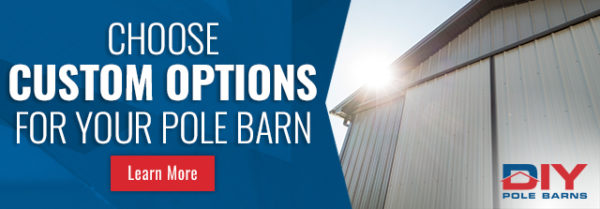It’s easy to get lost in the excitement of planning your new pole barn. While you’re focused on what equipment you put in it, where you’ll house your livestock or other minutia of how you plan to use it, you don’t want to forget about usability and comfort! Pole barn ventilation is one aspect of planning that you should spend some time considering.
The importance of pole barn ventilation can’t be overstated. Even pole barns used for storage will benefit from preventing stale air and extreme temperatures. Read on to learn about the pitfalls of poor ventilation and what you can do to avoid them!
Pole Barn Moisture Issues
Like any structure, a lack of proper pole barn ventilation can lead to moisture-related issues. Moisture is one of the fastest ways to cause problems with any structure. While it’s unlikely to cause a risk to the stability of your pole barn, it can cause some usability problems that won’t be ideal for you, your equipment, or your homestead’s animals.
Humidity & Condensation
Poor ventilation means the air conditions in your pole barn will hold whatever level of humidity they have. If it’s dry, it will stay dry. But if it’s humid, that humidity won’t have anywhere to go.
Humidity or condensation can damage equipment or feed stored in the barn, cause wear or shorts with electrical systems or leave animals vulnerable to illnesses.
Mold
It goes without saying that moisture always leads to a risk of mold. Nobody wants to deal with it, but it’s a reality when it comes to humid areas of the country or locations with heavy rain. Once moisture breaches your barn, mold can be an issue until it’s dealt with.
Pole Barn Air Flow Issues
If moisture isn’t a problem, poor pole barn ventilation can still be an issue you need to manage. Here are a few common cases that a pole barn built without consideration for air flow may run into:
Stale Air
Whether you use your pole barn for a hobby shop, a man cave or to keep animals, stagnant air is a problem. For people, the primary issue will be comfort. Stale air is often identified by irritated eyes or throat. You may start to cough or even have trouble breathing!
When air can’t move through your pole barn, all the dust and particulates inside will simply shift around. If you keep it locked tight between uses without any ventilation, it will accumulate with few chances to escape.
When it comes to animals like horses, it can spell even more serious problems. Their chances of developing respiratory infections can increase, and it’s generally uncomfortable for them even if they don’t.
Heat & Drafts
Like stale air, excessive heat or chills can be the norm in an unregulated pole barn. The most obvious issue with poor airflow is extreme weather conditions. The hottest and coldest seasons of the month will turn a basic building with no ventilation into an oven or freezer, respectively.
Controlling the temperature in a pole barn is often an important part of planning. Unless it’ll only be used for storage, you’ll want to consider your options for heating and cooling your barn to ensure comfort and good health for you or your animals.
Tips for Improving Pole Barn Ventilation
Build for Ventilation
The best way to prepare your pole barn for ventilation is to build it with airflow in mind. There are a few easy ways to accomplish this:
Insulation is key. Everything from your walls to your roof should be properly insulated. Pole barn insulation is a core part of temperature control and ventilation.
Don’t skip features that can increase airflow. Additional doors and windows will both help increase the general flow of air through your pole barn. Place them in ways that allow air to enter and exit in a clear path to maximize the movement of air.
Face your pole barn to allow proper airflow. When planning your placement, if you can, choose a position that allows some airflow to naturally blow from opening to opening. This will let natural breezes move air in and out of your pole barn.
Incorporate Fans
It’s not difficult to power your pole barn – if you follow your local building codes! When you have electricity, you can supplement natural means of pole barn ventilation with the addition of fans.
Fans make it easy to force air through your pole barn and prevent stagnation. They’re also important if you’re an equestrian building a pole barn for your horses!
Passive Venting Solutions
DIY Pole Barn’s instant quote tool includes some additional features to help with ventilation:
Cupola & Weathervane
A cupola is a classic way to help create more ventilation in your pole barn. These additions create a space at the top of your pole barn, covered by a decorative-styled cap to prevent moisture from entering.
In addition to the cupola, we have several weathervanes you can include on your cupola to help give it more of a personalized touch!
Continuous Ridge Vent
If your pole barn is going to house livestock, a continuous ridge vent is a necessity! These strips contour to the rib so your roof and seal the natural gap at the top of your roof, while remaining breathable to allow additional ventilation.
They also help fight condensation, which will keep your pole barn more comfortable and prevent potential health issues for livestock or those using the barn for personal hobbies or storage!
Build Your Pole Barn – Get an Instant Quote Online!
If you’re ready to build your pole barn, lock in a quote with DIY Pole Barns using our Instant Quote tool! Have questions? Call our knowledgeable staff at (937) 547-9100.
Connect with us on social media!




